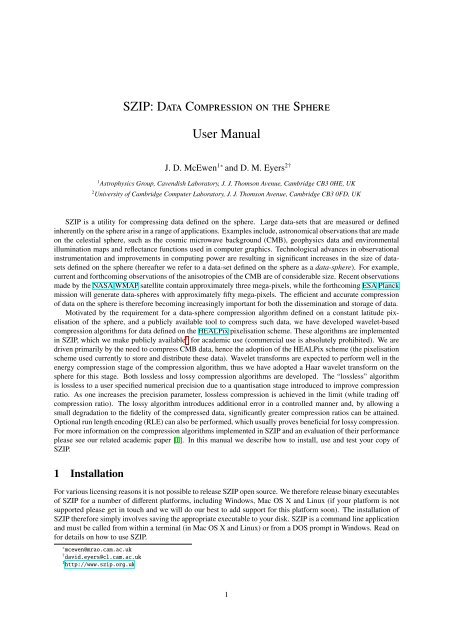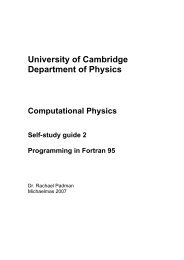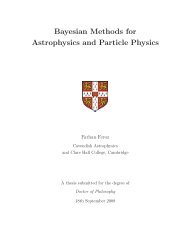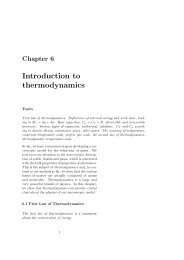SZIP: Data Compression on the Sphere User Manual
SZIP: Data Compression on the Sphere User Manual
SZIP: Data Compression on the Sphere User Manual
Create successful ePaper yourself
Turn your PDF publications into a flip-book with our unique Google optimized e-Paper software.
<str<strong>on</strong>g>SZIP</str<strong>on</strong>g>: <str<strong>on</strong>g>Data</str<strong>on</strong>g> <str<strong>on</strong>g>Compressi<strong>on</strong></str<strong>on</strong>g> <strong>on</strong> <strong>the</strong> <strong>Sphere</strong><br />
<strong>User</strong> <strong>Manual</strong><br />
J. D. McEwen 1∗ and D. M. Eyers 2†<br />
1 Astrophysics Group, Cavendish Laboratory, J. J. Thoms<strong>on</strong> Avenue, Cambridge CB3 0HE, UK<br />
2 University of Cambridge Computer Laboratory, J. J. Thoms<strong>on</strong> Avenue, Cambridge CB3 0FD, UK<br />
<str<strong>on</strong>g>SZIP</str<strong>on</strong>g> is a utility for compressing data defined <strong>on</strong> <strong>the</strong> sphere. Large data-sets that are measured or defined<br />
inherently <strong>on</strong> <strong>the</strong> sphere arise in a range of applicati<strong>on</strong>s. Examples include, astr<strong>on</strong>omical observati<strong>on</strong>s that are made<br />
<strong>on</strong> <strong>the</strong> celestial sphere, such as <strong>the</strong> cosmic microwave background (CMB), geophysics data and envir<strong>on</strong>mental<br />
illuminati<strong>on</strong> maps and reflectance functi<strong>on</strong>s used in computer graphics. Technological advances in observati<strong>on</strong>al<br />
instrumentati<strong>on</strong> and improvements in computing power are resulting in significant increases in <strong>the</strong> size of datasets<br />
defined <strong>on</strong> <strong>the</strong> sphere (hereafter we refer to a data-set defined <strong>on</strong> <strong>the</strong> sphere as a data-sphere). For example,<br />
current and forthcoming observati<strong>on</strong>s of <strong>the</strong> anisotropies of <strong>the</strong> CMB are of c<strong>on</strong>siderable size. Recent observati<strong>on</strong>s<br />
made by <strong>the</strong> NASA WMAP satellite c<strong>on</strong>tain approximately three mega-pixels, while <strong>the</strong> forthcoming ESA Planck<br />
missi<strong>on</strong> will generate data-spheres with approximately fifty mega-pixels. The efficient and accurate compressi<strong>on</strong><br />
of data <strong>on</strong> <strong>the</strong> sphere is <strong>the</strong>refore becoming increasingly important for both <strong>the</strong> disseminati<strong>on</strong> and storage of data.<br />
Motivated by <strong>the</strong> requirement for a data-sphere compressi<strong>on</strong> algorithm defined <strong>on</strong> a c<strong>on</strong>stant latitude pixelisati<strong>on</strong><br />
of <strong>the</strong> sphere, and a publicly available tool to compress such data, we have developed wavelet-based<br />
compressi<strong>on</strong> algorithms for data defined <strong>on</strong> <strong>the</strong> HEALPix pixelisati<strong>on</strong> scheme. These algorithms are implemented<br />
in <str<strong>on</strong>g>SZIP</str<strong>on</strong>g>, which we make publicly available 1 for academic use (commercial use is absolutely prohibited). We are<br />
driven primarily by <strong>the</strong> need to compress CMB data, hence <strong>the</strong> adopti<strong>on</strong> of <strong>the</strong> HEALPix scheme (<strong>the</strong> pixelisati<strong>on</strong><br />
scheme used currently to store and distribute <strong>the</strong>se data). Wavelet transforms are expected to perform well in <strong>the</strong><br />
energy compressi<strong>on</strong> stage of <strong>the</strong> compressi<strong>on</strong> algorithm, thus we have adopted a Haar wavelet transform <strong>on</strong> <strong>the</strong><br />
sphere for this stage. Both lossless and lossy compressi<strong>on</strong> algorithms are developed. The “lossless” algorithm<br />
is lossless to a user specified numerical precisi<strong>on</strong> due to a quantisati<strong>on</strong> stage introduced to improve compressi<strong>on</strong><br />
ratio. As <strong>on</strong>e increases <strong>the</strong> precisi<strong>on</strong> parameter, lossless compressi<strong>on</strong> is achieved in <strong>the</strong> limit (while trading off<br />
compressi<strong>on</strong> ratio). The lossy algorithm introduces additi<strong>on</strong>al error in a c<strong>on</strong>trolled manner and, by allowing a<br />
small degradati<strong>on</strong> to <strong>the</strong> fidelity of <strong>the</strong> compressed data, significantly greater compressi<strong>on</strong> ratios can be attained.<br />
Opti<strong>on</strong>al run length encoding (RLE) can also be performed, which usually proves beneficial for lossy compressi<strong>on</strong>.<br />
For more informati<strong>on</strong> <strong>on</strong> <strong>the</strong> compressi<strong>on</strong> algorithms implemented in <str<strong>on</strong>g>SZIP</str<strong>on</strong>g> and an evaluati<strong>on</strong> of <strong>the</strong>ir performance<br />
please see our related academic paper [1]. In this manual we describe how to install, use and test your copy of<br />
<str<strong>on</strong>g>SZIP</str<strong>on</strong>g>.<br />
1 Installati<strong>on</strong><br />
For various licensing reas<strong>on</strong>s it is not possible to release <str<strong>on</strong>g>SZIP</str<strong>on</strong>g> open source. We <strong>the</strong>refore release binary executables<br />
of <str<strong>on</strong>g>SZIP</str<strong>on</strong>g> for a number of different platforms, including Windows, Mac OS X and Linux (if your platform is not<br />
supported please get in touch and we will do our best to add support for this platform so<strong>on</strong>). The installati<strong>on</strong> of<br />
<str<strong>on</strong>g>SZIP</str<strong>on</strong>g> <strong>the</strong>refore simply involves saving <strong>the</strong> appropriate executable to your disk. <str<strong>on</strong>g>SZIP</str<strong>on</strong>g> is a command line applicati<strong>on</strong><br />
and must be called from within a terminal (in Mac OS X and Linux) or from a DOS prompt in Windows. Read <strong>on</strong><br />
for details <strong>on</strong> how to use <str<strong>on</strong>g>SZIP</str<strong>on</strong>g>.<br />
∗ mcewen@mrao.cam.ac.uk<br />
† david.eyers@cl.cam.ac.uk<br />
1 http://www.szip.org.uk<br />
1
2 Usage<br />
<str<strong>on</strong>g>SZIP</str<strong>on</strong>g> must be run from <strong>the</strong> command line (from within a terminal in Linux or Mac OS X; from a DOS prompt in<br />
Windows). Currently, support is <strong>on</strong>ly provided to compress HEALPix pixelised data-spheres, although in future we<br />
may add support for o<strong>the</strong>r pixelisati<strong>on</strong>s of <strong>the</strong> sphere (please c<strong>on</strong>tact us if this would be useful for you). Moreover,<br />
<strong>on</strong>ly HEALPix data-spheres in <strong>the</strong> NESTED format can be compressed by <str<strong>on</strong>g>SZIP</str<strong>on</strong>g>; data-spheres in <strong>the</strong> RING format<br />
are not accepted. We cannot currently support data-spheres in RING format since we are not able to release <str<strong>on</strong>g>SZIP</str<strong>on</strong>g><br />
as open source and so cannot use HEALPix code to c<strong>on</strong>vert between RING and NESTED formats. We may add<br />
functi<strong>on</strong>ality to <str<strong>on</strong>g>SZIP</str<strong>on</strong>g> in future to support RING ordered data-spheres but hope that potential users can c<strong>on</strong>vert <strong>the</strong>ir<br />
RING ordered data to a NESTED format (using, say, HEALPix) before compressing <strong>the</strong>ir data.<br />
The <str<strong>on</strong>g>SZIP</str<strong>on</strong>g> utility itself provides basic usage help by printing a list and brief descripti<strong>on</strong> of all command line<br />
opti<strong>on</strong>s. To view this list simply run <str<strong>on</strong>g>SZIP</str<strong>on</strong>g> with <strong>the</strong> --help opti<strong>on</strong>. For example, running<br />
>> ./szip --help<br />
will print <strong>the</strong> following usage informati<strong>on</strong>:<br />
<str<strong>on</strong>g>SZIP</str<strong>on</strong>g> data sphere compressi<strong>on</strong> utility<br />
(c) 2007 Jas<strong>on</strong> McEwen and Dave Eyers<br />
Usage:<br />
-h --help Prints this help<br />
-c --compress Compress input file<br />
-x --decompress Extract compressed input file<br />
-i --input Input file<br />
-o --output Output file<br />
-l --level <str<strong>on</strong>g>Compressi<strong>on</strong></str<strong>on</strong>g> level [default=1]<br />
-p --sigfig Precisi<strong>on</strong> (no. of significant figures) [default=5]<br />
-r --rle Run length encoding<br />
-y --lossy Loss factor (percentage to keep) [default=100]<br />
-b --nbins Number of bins used to compute threshold in lossy compressi<strong>on</strong> [default=100]<br />
-q --quiet Surpress comments and warnings<br />
-t --time Run profiler<br />
-v --versi<strong>on</strong> Print versi<strong>on</strong> number<br />
Ei<strong>the</strong>r <strong>the</strong> short <strong>on</strong>e character command line opti<strong>on</strong>s or <strong>the</strong> l<strong>on</strong>ger opti<strong>on</strong>s (both shown above) can be used interchangeably.<br />
We now go <strong>on</strong> to explain each of <strong>the</strong> command line opti<strong>on</strong>s shown in <strong>the</strong> usage list above.<br />
• --help<br />
Print usage informati<strong>on</strong>.<br />
• --compress<br />
Run <str<strong>on</strong>g>SZIP</str<strong>on</strong>g> in compress mode to compress an input .fits data-sphere (<strong>the</strong> input file must be a HEALPix datasphere<br />
in <strong>the</strong> NESTED ordering scheme).<br />
• --decompress<br />
Run <str<strong>on</strong>g>SZIP</str<strong>on</strong>g> in decompress mode to decompress an input .sip compressed file.<br />
• --input <br />
Specify <strong>the</strong> input file as . If running <str<strong>on</strong>g>SZIP</str<strong>on</strong>g> in compress mode this file must have a .fits extensi<strong>on</strong>;<br />
if running in decompress mode this file must have a .szip extensi<strong>on</strong>.<br />
• --output <br />
Specify <strong>the</strong> output file as . If running <str<strong>on</strong>g>SZIP</str<strong>on</strong>g> in compress mode this file must have a .szip extensi<strong>on</strong>;<br />
if running in decompress mode this file must have a .fits extensi<strong>on</strong>. If no output file is specified <strong>the</strong>n it will<br />
be set automatically with <strong>the</strong> same name as <strong>the</strong> input file but with <strong>the</strong> appropriate extensi<strong>on</strong>.<br />
2
• --level <br />
Specify <strong>the</strong> wavelet analysis depth to perform Haar wavelet transform down to as num. By default this value<br />
is set to 1, which should be suitable for most applicati<strong>on</strong>s. For fur<strong>the</strong>r detail see our related paper [1], where<br />
is denoted by <strong>the</strong> variable J0.<br />
• --sigfig <br />
Specify <strong>the</strong> precisi<strong>on</strong> parameter to use in <strong>the</strong> quantisati<strong>on</strong> stage as . By default this value is set to 5.<br />
Increasing this value improves <strong>the</strong> fidelity of compressi<strong>on</strong> but trades off compressi<strong>on</strong> ratio performance. This<br />
parameter actually specifies <strong>the</strong> number of significant figures to retain in <strong>the</strong> representati<strong>on</strong> of <strong>the</strong> wavelet<br />
detail coefficients.<br />
• --rle<br />
Perform run length encoding (RLE) in additi<strong>on</strong> to <strong>the</strong> usual Huffman encoding. It usually proves beneficial<br />
to include RLE when performing lossy compressi<strong>on</strong> but not for lossless compressi<strong>on</strong> (since RLE introduces<br />
an additi<strong>on</strong>al coding overhead)<br />
• --lossy <br />
Perform lossy compressi<strong>on</strong> and specify <strong>the</strong> loss factor as . The loss factor determines <strong>the</strong> proporti<strong>on</strong><br />
of detail coefficients to retain in <strong>the</strong> lossy compressi<strong>on</strong> and may range from 0 to 100 percent. By default<br />
this factor is set to 100 (i.e. all detail coefficients are retained) and lossless compressi<strong>on</strong> is performed.<br />
• --nbins <br />
Specify by <strong>the</strong> number of bins to use when c<strong>on</strong>structing <strong>the</strong> histogram used to determine <strong>the</strong> threshold<br />
level required to retain <strong>the</strong> appropriate porti<strong>on</strong> of detail coefficients in lossy compressi<strong>on</strong>.<br />
• --quiet<br />
Suppress comments and warnings that are o<strong>the</strong>rwise printed when running <str<strong>on</strong>g>SZIP</str<strong>on</strong>g>.<br />
• --time<br />
Run timing profiler when running <str<strong>on</strong>g>SZIP</str<strong>on</strong>g>.<br />
• --versi<strong>on</strong><br />
Print <str<strong>on</strong>g>SZIP</str<strong>on</strong>g> versi<strong>on</strong> number.<br />
We now give a couple of examples of running <str<strong>on</strong>g>SZIP</str<strong>on</strong>g> with various command line opti<strong>on</strong>s. To compress <strong>the</strong><br />
data-sphere sky.fits with default parameter values run<br />
>> ./szip --compress --input sky.fits<br />
or equivalently<br />
>> ./szip -c -i sky.fits<br />
These commands will produce <strong>the</strong> compressed file sky.szip. To decompress this file run<br />
>> ./szip --decompress --input sky.szip --output sky_rec<strong>on</strong>.fits<br />
or equivalently<br />
>> ./szip -x -i sky.szip -o sky_rec<strong>on</strong>.fits<br />
No parameter values are used in <strong>the</strong> decompressi<strong>on</strong> stage so <strong>the</strong>se last two commands can always be used to decompress<br />
<str<strong>on</strong>g>SZIP</str<strong>on</strong>g> files (of course, with <strong>the</strong> appropriate filenames). To compress sky.fits with a precisi<strong>on</strong> parameter<br />
of 4, using lossy compressi<strong>on</strong> to retain <strong>on</strong>ly 10 percent of wavelet detail coefficients and to add RLE run<br />
>> ./szip --compress --input sky.fits --output sky_p4_y10_rle.szip --sigfig 4 --rle --lossy 10<br />
or equivalently<br />
>> ./szip -c -i sky.fits -o sky_p4_y10_rle.szip -p 4 -r -y 10<br />
3
3 Testing<br />
(a) Original data<br />
(b) Decompressed data<br />
Figure 1: Simulated CMB data before and after compressi<strong>on</strong>-decompressi<strong>on</strong>.<br />
To test your copy of <str<strong>on</strong>g>SZIP</str<strong>on</strong>g> we make a simulated CMB map available <strong>on</strong> <strong>the</strong> <str<strong>on</strong>g>SZIP</str<strong>on</strong>g> web site: gcmb001 n256 nest.fits.<br />
An image of this map is shown in Fig. 1 (a). Compress and decompress <strong>the</strong>se data by running<br />
>> ./szip -c -i gcmb001_n256_nest.fits<br />
followed by<br />
>> ./szip -x -i gcmb001_n256_nest.szip -o gcmb001_n256_nest_rec<strong>on</strong>.fits<br />
An image of <strong>the</strong> rec<strong>on</strong>structed map is shown in Fig. 1 (b). This should match an image of <strong>the</strong> decompressed map<br />
you obtain by running your local copy of <str<strong>on</strong>g>SZIP</str<strong>on</strong>g>. Notice <strong>the</strong> small error between Fig. 1 (a) and (b), apparent from<br />
<strong>the</strong> different limits <strong>on</strong> <strong>the</strong> colour bars. This error arises since compressi<strong>on</strong> has been performed with a precisi<strong>on</strong><br />
parameter of 5 (<strong>the</strong> default value). By increasing <strong>the</strong> precisi<strong>on</strong> parameter <strong>the</strong> rec<strong>on</strong>structi<strong>on</strong> error can be reduced. A<br />
detailed study of <strong>the</strong> trade off between <strong>the</strong> fidelity of <strong>the</strong> compressed data against compressi<strong>on</strong> ratio is performed<br />
in our related paper [1]. Fur<strong>the</strong>rmore, we also discuss <strong>the</strong> cosmological implicati<strong>on</strong>s of <strong>the</strong>se types of error <strong>on</strong><br />
CMB data.<br />
Hopefully your <str<strong>on</strong>g>SZIP</str<strong>on</strong>g> installati<strong>on</strong> is working successfully. We hope you enjoy <str<strong>on</strong>g>SZIP</str<strong>on</strong>g> and that it proves useful<br />
for your particular applicati<strong>on</strong>. Any feedback <strong>on</strong> <strong>the</strong> current versi<strong>on</strong> or suggesti<strong>on</strong>s for improvements would be<br />
warmly received. If you do use <str<strong>on</strong>g>SZIP</str<strong>on</strong>g> in academic work that results in publicati<strong>on</strong> please reference <strong>the</strong> <str<strong>on</strong>g>SZIP</str<strong>on</strong>g> home<br />
page 2 and our paper [1].<br />
2 http://www.szip.org.uk<br />
4
References<br />
[1] J. D. McEwen, Y. Wiaux and D. M. Eyers, <str<strong>on</strong>g>Data</str<strong>on</strong>g> compressi<strong>on</strong> <strong>on</strong> <strong>the</strong> sphere, Astr<strong>on</strong>. & Astrophys., 531, A98,<br />
2011<br />
5






